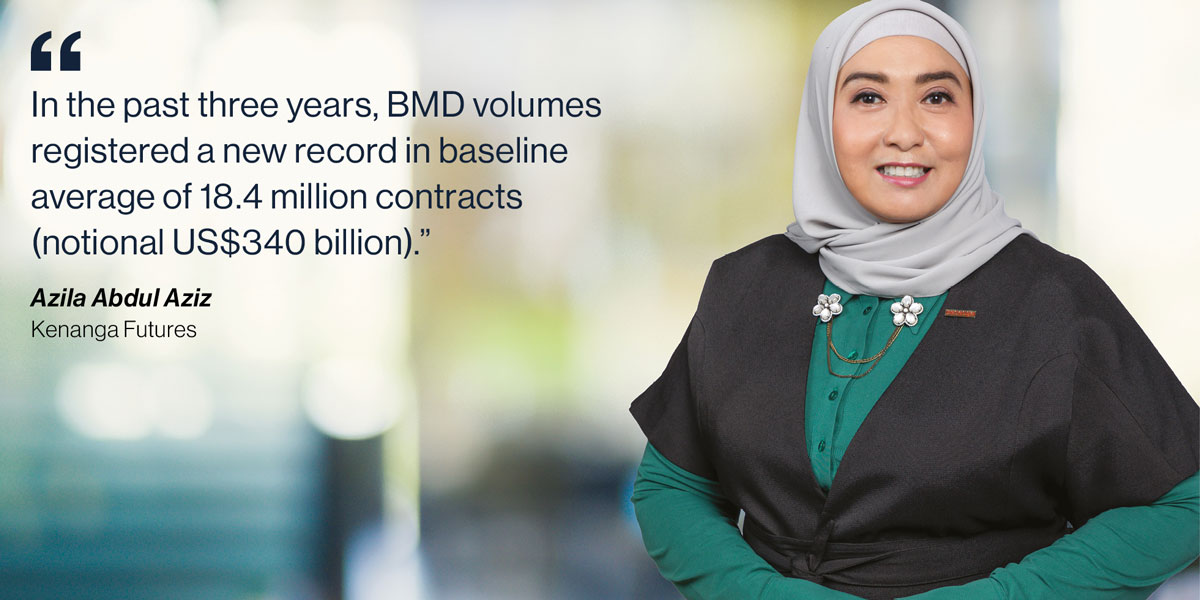
Azila Abdul Aziz, CEO, executive director and head of listed derivatives at Kenanga Futures, discusses navigating the derivatives industry and shaping the leaders of tomorrow.
What are the key trends in Malaysian derivatives right now?
We are seeing growing participation from global institutions, where more than half of overall market derivatives activity driven by foreign participation. One segment that has grown larger in scale in the past two years is the high frequency trading (HFT) and automated market making firms segment. The further extension of the CME’s Globex hosting is economically and logistically beneficial for clients located in the US and Europe. One caveat of CME Globex is that while trading is made 23 ½ hours in many other US or European derivatives, Bursa Malaysia Derivatives (BMD) products are only traded during local hours 8:45 am to 6:00 pm Malaysia. The introduction of the extended trading hours (T+1) has attracted new flows from the western hemisphere and added another 10-15% in volume to the overall activities traded during Malaysia’s regular hours.
Other fundamental factors driving trading into Malaysian derivatives is a cost-effective Malaysian Ringgit, that has largely stayed soft against the US dollar, creating avenues for investment in Malaysian assets and consequently, increasing hedging activities on the derivatives exchange.
What growth has Kenanga Futures seen this year, and what has contributed to this?
In the past three years, BMD volumes registered a new record in baseline average of 18.4 million contracts (notional US$340 billion) per annum, more than 30% increase from the years prior to Covid-19. Today, based on the 1H24 volumes, we are already at almost 60% of last year’s volumes, and if such momentum continues, there is a potential for Bursa Malaysia Derivatives markets to register a new record high, in excess of 20 million contracts (notional US$370 billion). Much of the activity in derivatives is driven by liquidity and volatility. We are seeing strong global participation, which now accounts for more than 60% of derivatives activity today – a big jump from 45% prior to Covid-19; whilst domestic liquidity takes up the balance of 40%. In line with the rest of other SEA currencies, the Malaysia Ringgit has remained relatively weak against the US dollar for most of 1H24. As a consequence, a weakening currency simply means an increase in the number of futures hedging activities that is in proportionate to the drop in currency value, as players adjust exposure in market swings. Such increase in market volatility has also attracted more directional trading looking for alpha returns, which gave rise to futures transactions.
How does Kenanga Futures sit within the wider global derivatives industry, and what lessons have you taken from other markets? How have you applied these in Malaysia?
Futures brokers are the key gateway for the buy- and sell-side clients to access emerging markets like Malaysia. BMD prohibits non-trading and non-clearing members from trading on the Exchange. Today, there are 16 trading participants (TPs) registered on BMD which includes global names like JP Morgan, Philip Capital, UOB Kay Hian and several other domestic names. Armed with deep bench of staff with derivatives experience, our core strength is attracting institutions and corporate businesses, including major banks, hedge funds, corporate hedgers, high-frequency trading firms, and proprietary trading firms across the US, Europe, and Asia-Pacific.
Being a listed derivatives broker in Malaysia and having a diverse clientele base both on the international and domestic front, we strive to be responsive to any emerging opportunities. Our business mix comprise of 75% from Global Institutional segment and balance 25% Domestic. Given that we are the conduit broker for a large percentage of global clients; we act as a window to the global developments impacting our clients, and we respond in real time where possible. Over the years, we have learned and experienced a great deal in servicing global clients. This ranges from understanding the impact of home-country regulations on our clients (such as ESMA or CFTC rules) to accessing Asian markets and advising on best solutions.
What are the biggest opportunities in the derivatives space right now?
If you look at the bigger picture, Malaysia, through its strong palm oil, rubber, electronics and natural gas industries continues to grow at an encouraging pace. And, as a commodity-rich country, Malaysia is attracting both local and foreign investors. Being one the largest producers and exporters of palm oil, Malaysia has successfully built a global market centre for crude palm oil trading. The attractiveness of the market should continue to draw investor attention going forward as products evolve with usage and diversity of the commodity increases. Without a doubt, the advent of electronic access has been the game-changer in driving growth in volumes and open interests notably in the crude palm oil futures contract (FCPO), the most actively traded on Bursa Malaysia Derivatives, to a new record high volumes that we see today. When FCPO has reached the desired scale in average daily volumes, then perhaps it could be a prelude towards having palm oil to be included as a component in the rolling global commodity index. In this instance, it would create a new captive demand for investors to follow and trade into these contracts as part of commodities benchmarking strategy.
What can we expect from Kenanga Futures in the coming years? What new initiatives are on the horizon?
Our vision is to be a market leader in the listed derivatives industry that has a strong domestic foundation with global connectivity and expertise. We are dedicated in expanding our reach across both global and domestic markets through targeted sales strategies. These strategies are designed to address the distinct needs of various client segments, including financial institutions, corporations, high-frequency trading firms, as well as retail and high-net-worth individuals. A cornerstone of our approach is the diversification of our institutional and corporate clientele base, as we actively seek to diversify revenues for both inbound and outbound business.

